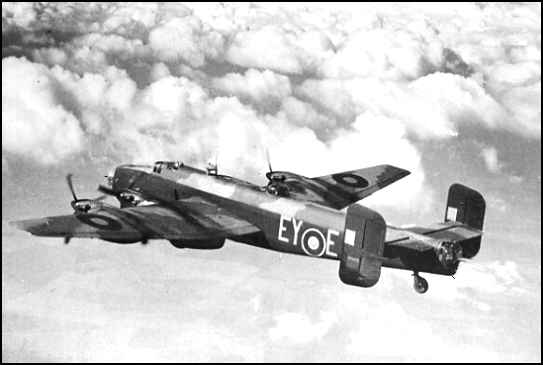
 |
|
Photo courtesy of Ian & Jill from the 57 RESCUE website |
|
via email from Bill Bucke, 8-18-12 Thank you for your reply - It will be 58 years come this August 31, that our crew was forced to bail out over the Irish Sea on a training flight in a MkIII Halifax aircraft. We were scheduled to drop practice bombs on a target on St.Tudwell's Island off the coast of N.Wales.We were flying at 20,000 feet when our inner starboard motor caught fire, we had been in the air roughly four hours. Our parachute was a "G.Q." Irvin type back pack. We had been instructed in parachute drill so we automatically followed prescribed procedures - I left the aircraft through the forward nose hatch - it was a tossup whether the navigator or I jumped first. Weather was not good that night - cumulonimbus clouds around us to a height of 40,000 feet. We figure we got out at 19,000 feet and drifted earthword driven by a wind speed of 60mph from the direction of 240 degrees. This was a blessing, it drifted us some five miles inland to a spot one mountain west of Snowdon in Cwm Pennant Valley. Time of the jump was 1:57 AM. In September 1989 I revisited the site where we landed - it was a great experience for both my wife and me. I met a local sheep farmer Mr. Evans who lived in the Valley - he was in the little one room school at the time and could remember the excitement of the Mountain Rescue Team going up the valley. I recently wrote several pages describing this experience for a recently retired Canadian Airforce Colonel who is compiling a book called "Navigator Tales" which he hopes will be published next spring. Anyhow, as you say, thank goodness for parachutes - my "G.Q." has given me a long and happy time. Best Regards: Bill Bucke 8-18-02 Editor's Note: I heartily recommend that you visit the website of Ian & Jill, 57 RESCUE. As they say in the introduction: "dedicated to the preservation of the Handley-Page Halifax. Of the 6,178 four- engined heavy bombers built during the Second World War, all were scrapped. Now, only three incomplete specimens remain." 57 RESCUE |


|